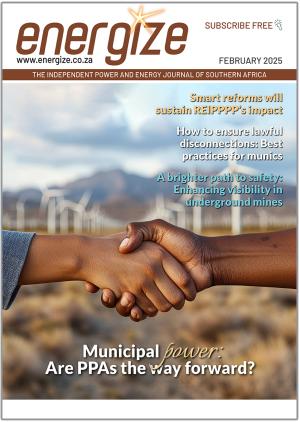South Africa’s plans to incorporate nuclear energy into its energy mix are gaining momentum. Industry experts say several sites, including decommissioned coal-fired power stations, have been identified for small-modular reactor (SMR) feasibility studies.
Stratek Global, a Pretoria-based company, has developed the HTMR-100, a high-temperature modular reactor that is helium gas-cooled and graphite-moderated. The design produces high-quality steam, which is coupled to a steam turbine system to produce a continuous base load of 35 MW of electrical power.
The company has received serious inquiries from countries interested in purchasing generating units, says Kelvin Kemm, Chairman and Chief Executive Officer of Stratek Global. “Enquiries are being received from Canada, Indonesia, the Middle East, Ireland and the United States, among others.”
This “first-to-market” nuclear reactor is set to accelerate the time to grid connection drastically, Kemm says. “South Africa has the potential to develop a valuable economic resource that should not be overlooked.”
He says the skills and expertise required for the construction, operation and maintenance of these environmentally friendly plants in South Africa are readily available. It uses TRi-structural ISOtropic particle fuel, which is made of cricket-ball-sized spheres manufactured locally.
“South Africa has a fully developed sector to handle, transport and store the fuel with ample facilities to dispose of it once it reaches the end of its useful life,” Kemm says.
Another environmental advantage of the HTMR-100 is that it uses helium for cooling, avoiding the need for large-volume water supplies in water-scarce areas. To minimise the possible danger of radiation overdose from the reactors, they could be housed in newer buildings at power stations, he adds.
Revitalisation of coal power stations
The City of Tshwane recently shared its plans to revitalise the Pretoria West and Rooiwal coal-driven power stations as part of its programme to secure 1 000 MW of additional capacity by 2026. Nuclear could form part of this mix, says Gerhard Odendaal, civil engineer and director of Status Management Services.
“Installing SMR units in decommissioned power stations has merit. All the infrastructure needed to operate the industry is already in place. This includes the buildings, transformers, switchgear, security and links to the national transmission grid – not to mention all the support items for a team of operators,” Odendaal tells Energize. “Everything needed to build, fuel, operate and maintain the units is available locally except for the pressure vessels, which are imported.”
Nuclear has distinct benefits over solar and wind technologies, offering a longer lifespan of up to 50 years, he adds. It can also be safely and economically installed within human settlements.
Vaalputs in South Africa houses a highly rated facility for disposing of used nuclear fuel. This large, remote area can accommodate additional radioactive material for centuries to come, Odendaal says. “Over time, nuclear waste loses its radioactivity, becoming less hazardous and more environmentally acceptable.”
Odendaal cautions that proper feasibility studies and professional supervision are vital prerequisites for such programmes.
2 500 MW of new generation
Energy and Electricity Minister Kgosientsho Ramokgopa reiterated government's plans to include nuclear power in its energy mix in a media briefing earlier this week.
Ramokgopa said efforts to secure funding for a new nuclear power plant were “at an advanced stage”. The plan requires National Treasury approval. Ramokgopa hopes it will be approved by August.
The government’s plan to procure 2 500 MW of nuclear energy is part of the Department of Mineral Resources and Energy’s Integrated Resource Plan 2019.















